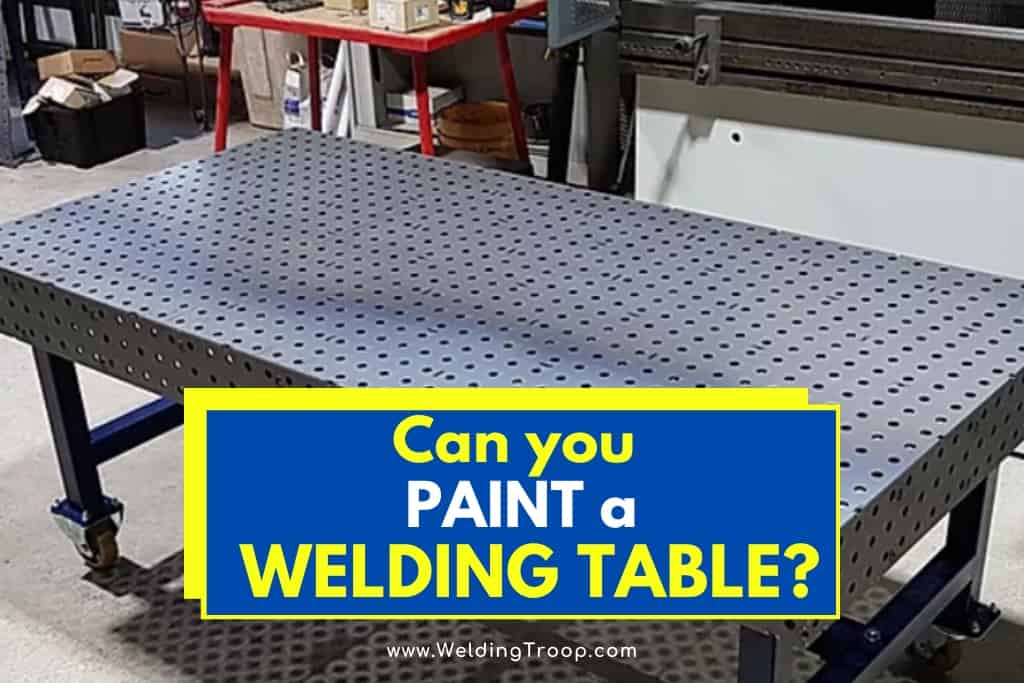Have you ever been into a welding bay and noticed that the welding tables are painted? That is not something one would usually notice, but since workshop owners often paint their machinery and storage units, it is something to consider.
Can you paint a welding table? No, because firstly paint is flammable and the sparks from the welding can cause the paint to burn, and in turn, burning paint turns into poisonous gases. Secondly, if you paint a welding table, the paint will prevent the welded item from being ‘earthed.’ Part of the welding equipment is fastened to the metal welding table, to ensure the welding piece is properly ‘earthed.’
There are other reasons why welding tables are not painted. Imagine working in a welding bay, all day, one would use welders, grinders, and all sorts of sharp objects to cut, hammer, and weld the metal fabrics together.
A hard, metal welding table will not show any marks, because the metal tabletop is made of a very strong, durable metal sheet. A painted table will look old in no time.
Table of Contents
How Do You Maintain Your Welding Table?
Welding tables develop metal splatter and rust, due to not being painted. Uneven spots from the welding make the table dirty and unlevel.
When you are trying to build something on the table, you want the table to be as clean, smooth, and as level as possible. This will ensure precision welding and fabrication.
Does Paint Affect Welding?
Yes, welding on painted materials can have negative effects on the quality of welds and pose health risks due to the hazardous gases released when paint is burned. When welding painted materials, it is important to wear a respirator and work in a well-ventilated area to minimize the risk of health issues.
Stick welding is the best technique for welding painted materials, and it is essential to grind some of the paint off the starting point to ensure good metal-to-metal contact. Choosing the right welding rod, such as 6010 or 6011, is crucial for a strong weld and deep penetration.
It’s also important to be cautious of fire and limit damage to the painted surface.
How Do I Protect My Welding Table From Spatter?
One way to protect your welding table from spatter is to use anti-spatter agents, such as the Siegmund Anti-Spatter, or anti-spatter spray. Another method is to use Sunoloy® weld spatter-resistant coatings, which are specially designed to prevent and repel weld spatter.
These coatings protect tooling, tables, and fixtures, and are a permanent alternative to self-applied pastes and spray-aerosols. They have excellent release and adhesion to all metals and are non-migratory, making them compatible with downstream painting operations.
However, when welding on painted materials, it is important to wear a respirator and work in a well-ventilated area due to hazardous gases released when paint is burned. Stick welding is the best technique, and grinding off some of the paint at the starting point is necessary for good metal-to-metal contact.
Choosing the right welding rod is crucial, and caution should be taken to limit damage to the painted surface.
Does Welding a Painted Surface May Cause Fumes?
Yes, welding on painted materials can cause fumes, and it can negatively affect the quality of welds. It can also pose health risks as fumes can come from coatings and residues on metal being welded, and some ingredients in coatings can have toxic effects.
Therefore, it is recommended to wear a respirator and work in a well-ventilated area when welding painted materials. Additionally, using stick welding and grinding off some of the paint can help ensure good metal-to-metal contact.
What Paint to Use After Welding?
After welding, it is recommended to coat the metal with an anti-rust treatment or paint to prevent corrosion and rusting. However, caution should be taken when welding on painted materials as it can cause fumes and negatively affect weld quality.
To ensure good metal-to-metal contact, it is recommended to grind off some of the paint before welding. When welding structural steel members, it is best to paint the steel in the shop or apply the top coat on-site to avoid damaging the coatings.
If welding through coatings cannot be avoided, proper personal protective equipment should be worn due to toxic fumes. Additionally, it is recommended to remove any corrosion damage associated with welds by abrasive blasting or with a Bristle Blaster before painting.
The coating system over the welded area should be identical to that of the steel generally to ensure continuous corrosion protection and overlapping should be used to prevent gaps or weak points. A stripe coat can also be used for additional coverage.
Read also >> 8 Best Welding Tables – Top Picks and Buying Guide
Read also >> Why do Welding Tables Have Holes? (Tips and Tricks You Need To Know)
Read also >> Should Welding Tables Be Grounded?
Read also >> How Thick Should a Welding Table Be?
Keeping Welding Tables Clean, Flat, Smooth and Rust-free
- Sweep the welding table: Using a brush or broom, sweep the table to get rid of small loose particles and dust.
- Grind the welding table, lightly: Using a hand grinder, and a flat disc or a cupped disc, grind off the high spots, left from the welding. Keep your grinder flat and use a sweeping movement across the table. This will take away all high spots.
- Wash the welding table: Once all the high spots are cleared, and the table is smooth, use acetone and a cloth to clean the table. This will not only clean the table of welding chips but also remove any oil or grease, which has ended up on the table.
- Lubricate the welding table: Finally, use WD40 (Amazon), and spray it all over the table. Wipe the table all over, and let it dry overnight. WD40 takes twelve hours to dry. In the morning, your table will be ready to use. WD40 is oil-based and will keep your table from rusting.
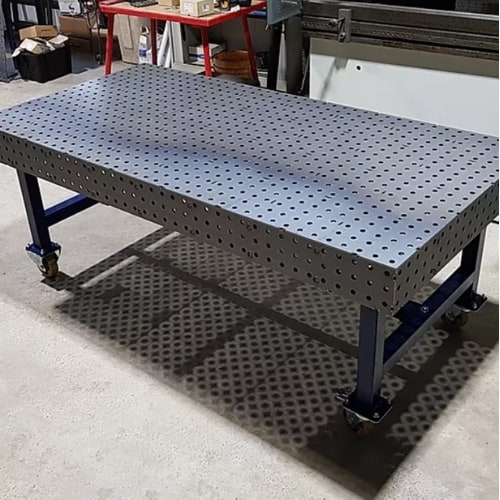
Features to Consider When Buying or Making a Welding Table:
| Features to Consider | Description |
| Construction Quality | The construction quality of a welding table is very important. The material used needs to be durable and last for years. People usually try to buy something less expensive, but quality is needed when buying welding tables. |
| Size and Height | The size of your welding table must be considered with great planning. It all depends on the type of work you do and the size of your working area. If you are an onsite welder, you will want a light, portable table, which can be folded and loaded into a vehicle, and installed on site. If you have a commercial business and a large workshop, you may need a large, heavy-duty table, which can accommodate vices, a guide rail, and a dust collector. The height of the welding table is most important. If the table is too low, the person will have to hunch forward, causing back pain. To eliminate this problem, it is worth buying a welding table with adjustable legs. Usually, square tubing is used, as it is best suited for adjustability. This will allow the user to adjust the legs to the correct height. |
| Weight | The weight of your welding table must be considered. If you do onsite welding jobs, you will need a lightweight table, which can be anchored to the ground, when onsite. If you work in a commercial workshop, and the welding table is very heavy, it may be best to choose a welding table with wheels. This will make it easier to move the table if needed. Before you continue reading, here is an article we wrote about How Thick Should a Welding Table Be? |
| Movement | Welding tables must be completely free of movement. Portable welding tables need to be anchored down onsite, while very large heavy commercial tables, must be made of very strong materials so that there is not swaying when work is in progress. If the tabletop of the welding table is very heavy, the legs need to be able to hold the weight of the table. They need to be equally as strong. |
| Motion Variations | A welding table should have a 360-degree motion variation. This will enable a person to weld horizontally. It is very convenient when welding upright joints. Upright clamping slots enable you to secure your workpiece horizontally. |
| Pricing Options | Welding tables, which cost over $1 000, have multiple features. For example, not only are you able to weld on them, but they can be used for grinding projects and plasma cutting. Higher priced welding tables have additional storage spaces for welding equipment and tools. These tables are suitable for large industrial applications. Welding tables, which cost under $500, are usually used for smaller projects. These welding tables are often portable, can be stored easily, and use a small amount of workshop space. There are very good quality welding tables in this price range. |
Stocking Your Welding Table and Work Area: 18 Must-Haves
You’ve got your table all set. Now, for the rest of your workspace. Here’s what you need to outfit your welding area.
- Welding Table: A welding table is needed to weld on. (check above: Features to Consider When Buying or Making a Welding Table)
- Welding Machinery: There are all types of welders, used for different purposes. There are MIG welding machines, TIG welding machines, and ARC welding machines. Large commercial companies usually have more than one type of welding machine, but smaller companies and individuals usually purchase a welding machine of their choice.
- Welding Helmet: A welding helmet is designed to protect your eyes, face, and neck from sparks, burns, and ultraviolet rays.

- Welding Jacket: A welding jacket is made of fire-resistant fabric and is designed to protect the welder from hot metal splatter and extreme heat.
- Safety Boots: It is very important to wear safety boots while working in a workshop environment. Safety boots have an inserted metal cap, installed inside the top of the shoe. This metal cap will protect your toes, should anything very heavy fall on your foot.
- Welding Gloves: There are different gloves for different types of welding. You can get gloves for Tig welding, MIG welding, and Stick (arc) welding. These gloves protect the welder’s hands from high heat and burns. They are made of tough material with a heat resistant lining.
- Safety Glasses: These should be used when grinding metal materials, they protect your eyes from sparks and tiny metal fragments, which my shoot into your eyes when grinding.
- Fire Extinguisher: Every company using welding equipment, must have a fire extinguisher, in case something catches on fire.
- Welding Wire or Welding Rods: A MIG welder uses welding wire when welding. When a welder is ARC welding, welding rods are used. This wire and these rods melt into the seam, attaching two pieces of metal.
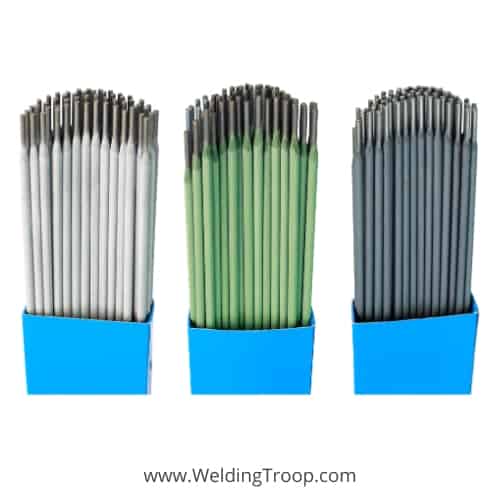
- Welding Magnets: These are heavy-duty magnets, which hold the two pieces of metal firmly in place so that they don’t move when welding.
- Welding Clamps: Welding clamps hold the two pieces of material together so that the pieces don’t move when welding them together.
- Vice Grips and Pliers: These can be used to pick up hot metal, which you are unable to pick up with your welding gloves.
- Chipping Hammer: A chipping hammer is used to remove welding slag from the welded area.
- Steel Wire Bush: This is used before your weld to clean off any sharp pieces of metal left over from the cutting process.
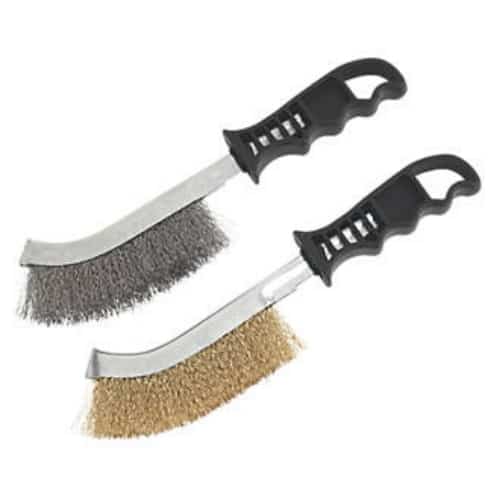
- Hand File: This is used to file away any sharp edges and burrs from the cutting process.
- Angle Grinder: A angle grinder is used to cut and polish metal before welding the material together.
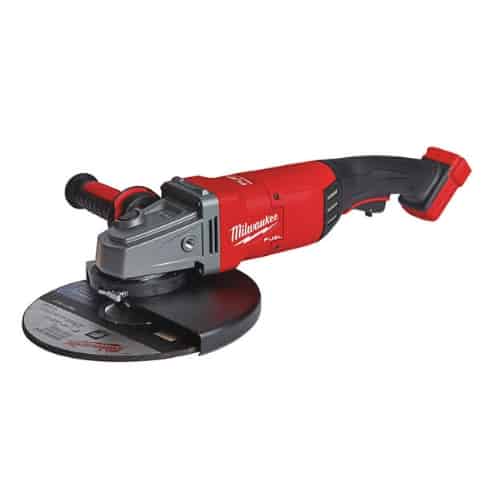
- Hacksaw: This is a manual metal cutting saw and is very handy because you do not need electric power to use it.
- Marking Tools: A scriber tool, soapstone, or a permanent marker can be used to mark the fabric before cutting or welding.
Recommended Reading
Should Welding Tables Be Grounded?
Why do Welding Tables Have Holes? >> Tips and Tricks You Need To Know

